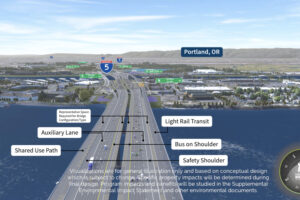Rep. Marie Gluesenkamp Perez (WA-03), along with Sens. Maria Cantwell (WA) and Patty Murray (WA) recently announced that the Interstate Bridge Replacement (IBR) Program – the organization tasked with replacing the I-5 Bridge connecting Southwest Washington and Portland – will receive $600 million in federal funds from the Department of Transportation’s (DOT) National Infrastructure Project Assistance program, or Mega program.
Rep. Marie Gluesenkamp Perez has spoken directly with U.S. Transportation Secretary Pete Buttigieg and hosted White House Infrastructure Implementation Coordinator Mitch Landrieu in September to underscore the urgent need for this funding to help replace the I-5 Bridge. Additionally, Rep. Gluesenkamp Perez, Sen. Cantwell and Sen. Murray co-led a bipartisan Washington delegation letter in August in support of the states’ Mega grant application.
The I-5 Bridge project received the highest amount of funding out of 11 awards nationwide. This year, the DOT sought applications for $1.8 billion in Mega program funding from Fiscal Years 2023 and 2024 advance appropriations. Today’s grant marks the second federal grant awarded to the current bridge replacement project; the first, a $1 million seismic study grant, was awarded in October 2022.
The DOT award will fund between 8% and 12% of the total bridge replacement project cost, which is estimated to be between $5 billion and $7.5 billion. The bridge replacement project remains eligible for other sources of federal funding, including the DOT Bridge Investment Program and the Federal Transit Administration Capital Investment Grant Program.
“From day one, it’s been my mission to bring our federal tax dollars back to Southwest Washington to replace the deteriorating, functionally obsolete I-5 Bridge. It’s the only way we get this huge project done. I pushed for critical Mega program funding every time I spoke with Secretary of Transportation Pete Buttigieg, and I brought White House Infrastructure Implementation Coordinator Mitch Landrieu to tour the bridge and understand the project,” said Rep. Gluesenkamp Perez.




